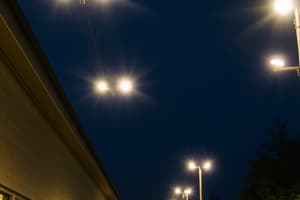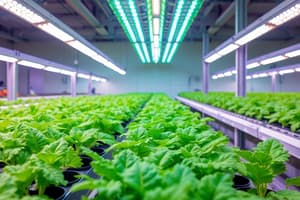Podcast
Questions and Answers
LED lights convert more electrical power into heat instead of light.
LED lights convert more electrical power into heat instead of light.
False (B)
Traditional incandescent bulbs have a longer lifespan compared to LED bulbs.
Traditional incandescent bulbs have a longer lifespan compared to LED bulbs.
False (B)
The energy savings from using LED lights result from their inefficient conversion of electrical power.
The energy savings from using LED lights result from their inefficient conversion of electrical power.
False (B)
LED lights are not commonly used in efforts to save electricity due to their high cost.
LED lights are not commonly used in efforts to save electricity due to their high cost.
The use of LED lights can contribute to reducing the environmental impact of energy consumption.
The use of LED lights can contribute to reducing the environmental impact of energy consumption.
LED lightbulbs have an average lifespan ranging from 25,000 to 50,000 hours, which is longer than compact fluorescence lamps and halogen lamps.
LED lightbulbs have an average lifespan ranging from 25,000 to 50,000 hours, which is longer than compact fluorescence lamps and halogen lamps.
LED lights emit light in all directions, which makes them less efficient than traditional bulbs.
LED lights emit light in all directions, which makes them less efficient than traditional bulbs.
The high color rendering index (CRI) of LED lights makes colors appear less natural.
The high color rendering index (CRI) of LED lights makes colors appear less natural.
One of the benefits of using LED lights is that they contribute to reducing the overall carbon footprint.
One of the benefits of using LED lights is that they contribute to reducing the overall carbon footprint.
LED lights are not suitable for industrial settings like factories and warehouses due to their short lifespan.
LED lights are not suitable for industrial settings like factories and warehouses due to their short lifespan.
Flashcards are hidden until you start studying
Study Notes
Saving Electricity with LED Lighting
Light Emitting Diodes (LED) have become increasingly popular due to their energy efficiency and longer lifespan compared to traditional incandescent bulbs. This has made them a key component of many efforts to save electricity. Here's how:
Table of Contents
- How LED Lights Save Energy
- Benefits of Using LED Lights to Save Electricity
- Examples of Using LED Lights to Save Electricity
How LED Lights Save Energy
Energy Efficient Design
The design of LED lights allows them to convert more of the electrical power they consume into light, rather than heat, which is why they don't get hot during operation like traditional incandescent bulbs. This efficient conversion results in less wasted energy and higher energy savings.
Longer Lifespan
LED bulbs typically last much longer than other types of lighting. The average lifespan of an LED lightbulb ranges from 25,000 to 50,000 hours, while compact fluorescence lamps and halogen lamps can only reach between 6,000 to 8,000 hours. This means LED lights can save electricity by reducing the frequency of bulb replacements.
Higher Quality Light Output
LED lights emit light in specific directions, making them highly efficient. They also provide a higher quality light output than traditional bulbs. For example, LED lights can deliver bright white light with high color rendering index (CRI), which makes colors appear more natural.
Benefits of Using LED Lights to Save Electricity
Cost Savings
By using less energy and lasting longer, LED lights can help consumers save money over time. Although they may have a higher initial cost than traditional bulbs, their long lifespan and energy efficiency make them more cost-effective in the long run.
Environmental Impact Reduction
More efficient lighting reduces the overall carbon footprint, both in terms of energy consumption and waste generated from frequent bulb replacements. This reduction in environmental impact helps conserve natural resources and reduce greenhouse gas emissions.
Increased Productivity
LED lights produce bright light and minimize glare, making them easier on the eyes and reducing eye strain. They can also provide better illumination for workspaces, improving productivity and safety.
Examples of Using LED Lights to Save Electricity
Residential Applications
LED lights can be used in various residential applications, such as lighting hallways, entryways, and outdoor spaces. They can also be used in recessed downlights, pendant lights, and under-cabinet task lighting.
Commercial Applications
In commercial settings, LED lights can be used for ambient and accent lighting, signage, and task lighting. They are also a popular choice for outdoor and landscape lighting.
Industrial Applications
Industrial settings, such as factories and warehouses, can benefit from the use of LED lights due to their high energy efficiency and longer lifespan. They can be used in high bay lighting, panel lighting, and flood lights.
LED lighting is an effective way to save electricity and reduce energy consumption. By adopting LED lights, consumers can enjoy cost savings, environmental benefits, and improved productivity.
Studying That Suits You
Use AI to generate personalized quizzes and flashcards to suit your learning preferences.





